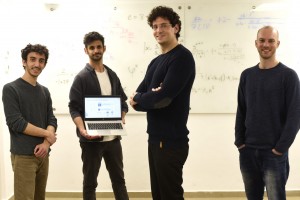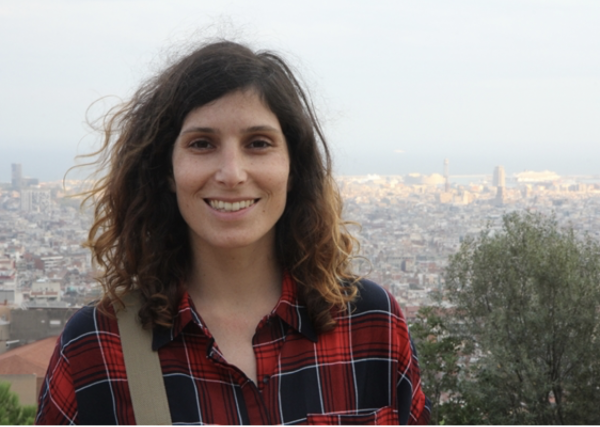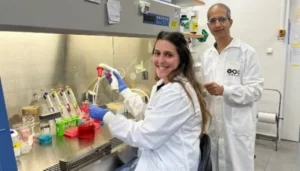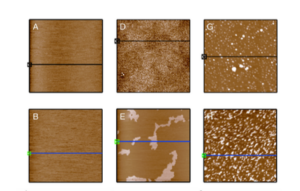Machine de Ramanujan : les chercheurs du Technion ont mis au point un générateur de conjectures mathématiques

[:fr]
En utilisant l’IA et l’automatisation informatique, les chercheurs du Technion ont mis au point un « générateur de conjectures » qui crée des conjectures mathématiques, considérées comme le point de départ de l’élaboration de théorèmes mathématiques. Ils l’ont utilisé pour générer un certain nombre de formules jusqu’alors inconnues. L’étude a été réalisée par des étudiants de premier cycle de différentes facultés sous la tutelle du Professeur assistant Ido Kaminer de la Faculté de génie électrique Andrew et Erna Viterbi du Technion.
Le projet porte sur l’un des éléments les plus fondamentaux des mathématiques : les constantes. Une constante mathématique est un nombre à valeur fixe qui émerge naturellement de différents calculs et de structures mathématiques dans différents domaines. De nombreuses constantes mathématiques sont d’une grande importance en mathématiques, mais aussi dans des disciplines qui y sont extérieures, notamment la biologie, la physique et l’écologie.
Le nombre d’or et le nombre d’Euler sont des exemples de ces constantes fondamentales. La constante la plus célèbre est peut-être pi, qui était étudiée dans l’Antiquité dans le contexte de la circonférence d’un cercle. Aujourd’hui, pi apparaît dans de nombreuses formules dans toutes les branches de la science, avec de nombreux amateurs de mathématiques qui se disputent le nombre de chiffres après le point décimal.
 Les chercheurs du Technion ont proposé et examiné une nouvelle idée : l’utilisation d’algorithmes informatiques pour générer automatiquement des conjectures mathématiques qui apparaissent sous la forme de formules de constantes mathématiques.
Les chercheurs du Technion ont proposé et examiné une nouvelle idée : l’utilisation d’algorithmes informatiques pour générer automatiquement des conjectures mathématiques qui apparaissent sous la forme de formules de constantes mathématiques.
Une conjecture est une conclusion ou une proposition mathématique qui n’a pas été prouvée ; une fois la conjecture prouvée, elle devient un théorème. La découverte d’une conjecture mathématique sur des constantes fondamentales est relativement rare, et sa source se trouve souvent dans le génie mathématique et l’intuition humaine exceptionnelle. Newton, Riemann, Goldbach, Gauss, Euler et Ramanujan sont des exemples de ce génie, et la nouvelle approche présentée dans le document porte le nom de Srinivasa Ramanujan.

Srinivasa Ramanujan, mathématicien indien né en 1887, a grandi dans une famille pauvre, mais a réussi à venir à Cambridge à l’âge de 26 ans à l’initiative des mathématiciens britanniques Godfrey Hardy et John Littlewood. Quelques années plus tard, il tombe malade et retourne en Inde, où il meurt à l’âge de 32 ans. Au cours de sa courte vie, il a accompli de grandes choses dans le monde des mathématiques. L’une des rares capacités de Ramanujan était la formulation intuitive de formules mathématiques non éprouvées. L’équipe de recherche du Technion a donc décidé de nommer son algorithme « la machine de Ramanujan », car il génère des conjectures sans les prouver, en « imitant » l’intuition grâce à l’IA et à une automatisation informatique considérable.
Selon le Pr Kaminer, « Nos résultats sont impressionnants car l’ordinateur se moque de savoir si la preuve de la formule est facile ou difficile, et ne base pas les nouveaux résultats sur des connaissances mathématiques préalables, mais seulement sur les nombres en constantes mathématiques. Dans une large mesure, nos algorithmes fonctionnent de la même manière que Ramanujan lui-même, qui a présenté des résultats sans preuve. Il est important de souligner que l’algorithme lui-même est incapable de prouver les conjectures qu’il a trouvées – à ce stade, la tâche est laissée à la discrétion des mathématiciens humains ».
Les conjectures générées par la machine de Ramanujan du Technion ont fourni de nouvelles formules pour des constantes mathématiques bien connues telles que pi, le nombre d’Euler (e), la constante d’Apéry (qui est liée à la fonction zêta de Riemann) et la constante catalane. Étonnamment, les algorithmes développés par les chercheurs du Technion ont réussi non seulement à créer des formules connues pour ces fameuses constantes, mais aussi à découvrir plusieurs conjectures jusqu’alors inconnues. Les chercheurs estiment que cet algorithme pourra accélérer considérablement la génération de conjectures mathématiques sur les constantes fondamentales et aider à identifier de nouvelles relations entre ces constantes.
Comme mentionné, jusqu’à présent, ces conjectures étaient basées sur un génie rare. C’est pourquoi, en des centaines d’années de recherche, seules quelques dizaines de formules ont été trouvées. Il n’a fallu que quelques heures à la machine Ramanujan du Technion pour découvrir toutes les formules de pi découvertes par Gauss, le « prince des mathématiques », au cours d’une vie de travail, ainsi que des dizaines de nouvelles formules inconnues de Gauss.

Selon les chercheurs, « des idées similaires peuvent à l’avenir conduire au développement de conjectures mathématiques dans tous les domaines des mathématiques, et fournir ainsi un outil significatif pour la recherche mathématique ».
L’équipe de recherche a lancé un site web, RamanujanMachine.com, qui vise à inciter le public à s’impliquer davantage dans l’avancement de la recherche mathématique en fournissant des outils algorithmiques qui seront mis à la disposition des mathématiciens et du grand public. Avant même la publication de l’article, des centaines d’étudiants, d’experts et de mathématiciens amateurs s’étaient inscrits sur le site web.
L’étude a commencé avec un projet de premier cycle dans le cadre du programme d’excellence Rothschild Scholars Technion avec la participation de Gal Raayoni et George Pisha, et s’est poursuivie dans le cadre des projets de recherche menés à la Faculté de génie électrique Andrew et Erna Viterbi avec la participation de Shahar Gottlieb, Yoav Harris et Doron Haviv. C’est également là que la percée la plus significative a été réalisée par un algorithme développé par Shahar Gottlieb qui a conduit à la publication de l’article dans Nature. Le Professeur Kaminer ajoute que la découverte mathématique la plus intéressante faite à ce jour par les algorithmes de la machine de Ramanujan concerne une nouvelle structure algébrique dissimulée dans une constante catalane. Cette structure a été découverte par un lycéen, Yahel Manor, qui a participé au projet dans le cadre du programme Alpha pour les jeunes orientés vers les sciences.
Le Pr Kaminer a ajouté que « les collègues industriels Uri Mendlovic et Yaron Hadad ont également participé à l’étude et ont largement contribué aux concepts mathématiques et algorithmiques qui constituent le fondement de la machine de Ramanujan. Il est important de souligner que l’ensemble du projet a été réalisé sur une base volontaire, n’a reçu aucun financement et les participants ont rejoint l’équipe par pure curiosité scientifique ».
Le Pr Ido Kaminer est chef du laboratoire de dynamique quantique des faisceaux d’électrons de Robert et Ruth Magid. Il est membre de la Faculté Andrew et Erna Viterbi de génie électrique et du Solid State Institute. Kaminer est affilié au Helen Diller Quantum Center et à l’Institut de nanotechnologie Russell Berrie.
Publication dans Nature, 3 février 2021
Source Technion France
[:en]
Using AI and computer automation, Technion researchers have developed a “conjecture generator” that creates mathematical conjectures, which are considered to be the starting point for developing mathematical theorems. They have already used it to generate a number of previously unknown formulas. The study, which was published in the journal Nature, was carried out by undergraduates from different faculties under the tutelage of Assistant Professor Ido Kaminer of the Andrew and Erna Viterbi Faculty of Electrical Engineering at the Technion.
Using AI and computer automation, Technion researchers have developed a “conjecture generator” that creates mathematical conjectures, which are considered to be the starting point for developing mathematical theorems. They have already used it to generate a number of previously unknown formulas. The study, which was published in the journal Nature, was carried out by undergraduates from different faculties under the tutelage of Assistant Professor Ido Kaminer of the Andrew and Erna Viterbi Faculty of Electrical Engineering at the Technion. The project deals with one of the most fundamental elements of mathematics – mathematical constants. A mathematical constant is a number with a fixed value that emerges naturally from different mathematical calculations and mathematical structures in different fields. Many mathematical constants are of great importance in mathematics, but also in disciplines that are external to mathematics, including biology, physics, and ecology. The golden ratio and Euler’s number are examples of such fundamental constants. Perhaps the most famous constant is pi, which was studied in ancient times in the context of the circumference of a circle. Today, pi appears in numerous formulas in all branches of science, with many math aficionados competing over who can recall more digits after the decimal point: 3.1415926535897932384626433832795028841971693993751058209749445923078164062862089986280348253421170679821480865132823066470938446095505822317253594081284811174502841027019385211055596446229489549303820…
The project deals with one of the most fundamental elements of mathematics – mathematical constants. A mathematical constant is a number with a fixed value that emerges naturally from different mathematical calculations and mathematical structures in different fields. Many mathematical constants are of great importance in mathematics, but also in disciplines that are external to mathematics, including biology, physics, and ecology. The golden ratio and Euler’s number are examples of such fundamental constants. Perhaps the most famous constant is pi, which was studied in ancient times in the context of the circumference of a circle. Today, pi appears in numerous formulas in all branches of science, with many math aficionados competing over who can recall more digits after the decimal point: 3.1415926535897932384626433832795028841971693993751058209749445923078164062862089986280348253421170679821480865132823066470938446095505822317253594081284811174502841027019385211055596446229489549303820…
The Technion researchers proposed and examined a new idea: The use of computer algorithms to automatically generate mathematical conjectures that appear in the form of formulas for mathematical constants.
A conjecture is a mathematical conclusion or proposition that has not been proved; once the conjecture is proved, it becomes a theorem. Discovery of a mathematical conjecture on fundamental constants is relatively rare, and its source often lies in mathematical genius and exceptional human intuition. Newton, Riemann, Goldbach, Gauss, Euler, and Ramanujan are examples of such genius, and the new approach presented in the paper is named after Srinivasa Ramanujan.

Ramanujan, an Indian mathematician born in 1887, grew up in a poor family, yet managed to arrive in Cambridge at the age of 26 at the initiative of British mathematicians Godfrey Hardy and John Littlewood. Within a few years, he fell ill and returned to India, where he died at the age of 32. During his brief life, he accomplished great achievements in the world of mathematics. One of Ramanujan’s rare capabilities was the intuitive formulation of unproven mathematical formulas. The Technion research team, therefore, decided to name their algorithm “the Ramanujan Machine,” as it generates conjectures without proving them, by “imitating” intuition using AI and considerable computer automation.
According to Prof. Kaminer, “Our results are impressive because the computer doesn’t care if proving the formula is easy or difficult, and doesn’t base the new results on any prior mathematical knowledge, but only on the numbers in mathematical constants. To a large degree, our algorithms work in the same way as Ramanujan himself, who presented results without proof. It’s important to point out that the algorithm itself is incapable of proving the conjectures it found – at this point, the task is left to be resolved by human mathematicians.”
The conjectures generated by the Technion’s Ramanujan Machine have delivered new formulas for well-known mathematical constants such as pi, Euler’s number (e), Apéry’s constant (which is related to the Riemann zeta function), and the Catalan constant. Surprisingly, the algorithms developed by the Technion researchers succeeded not only in creating known formulas for these famous constants, but in discovering several conjectures that were heretofore unknown. The researchers estimate this algorithm will be able to significantly expedite the generation of mathematical conjectures on fundamental constants and help to identify new relationships between these constants.

As mentioned, until now, these conjectures were based on rare genius. This is why in hundreds of years of research, only a few dozens of formulas were found. It took the Technion’s Ramanujan Machine just a few hours to discover all the formulas for pi discovered by Gauss, the “Prince of Mathematics,” during a lifetime of work, along with dozens of new formulas that were unknown to Gauss.
According to the researchers, “Similar ideas can in the future lead to the development of mathematical conjectures in all areas of mathematics, and in this way provide a meaningful tool for mathematical research.”
The research team has launched a website, RamanujanMachine.com, which is intended to inspire the public to be more involved in the advancement of mathematical research by providing algorithmic tools that will be available to mathematicians and the public at large. Even before the article was published, hundreds of students, experts, and amateur mathematicians had signed up to the website.
The research study started out as an undergraduate project in the Rothschild Scholars Technion Program for Excellence with the participation of Gal Raayoni and George Pisha, and continued as part of the research projects conducted in the Andrew and Erna Viterbi Faculty of Electrical Engineering with the participation of Shahar Gottlieb, Yoav Harris, and Doron Haviv. This is also where the most significant breakthrough was made – by an algorithm developed by Shahar Gottlieb – which led to the article’s publication in Nature. Prof. Kaminer adds that the most interesting mathematical discovery made by the Ramanujan Machine’s algorithms to date relates to a new algebraic structure concealed within a Catalan constant. The structure was discovered by high school student Yahel Manor, who participated in the project as part of the Alpha Program for science-oriented youth. Prof. Kaminer added that, “Industry colleagues Uri Mendlovic and Yaron Hadad also participated in the study, and contributed greatly to the mathematical and algorithmic concepts that form the foundation for the Ramanujan Machine. It is important to emphasize that the entire project was executed on a voluntary basis, received no funding, and participants joined the team out of pure scientific curiosity.”
Prof. Ido Kaminer is the head of the Robert and Ruth Magid Electron Beam Quantum Dynamics Laboratory. He is a faculty member in the Andrew and Erna Viterbi Faculty of Electrical Engineering and the Solid State Institute. Kaminer is affiliated with the Helen Diller Quantum Center and the Russell Berrie Nanotechnology Institute.
[:]







